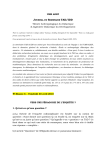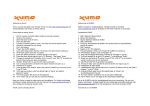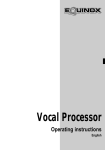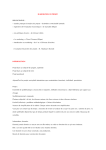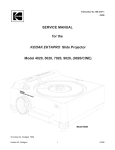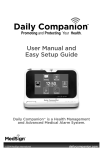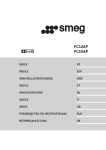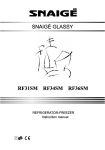Download Help: Problem Solving and Troubleshooting
Transcript
World 2011 Help! Problem Solving and Troubleshooting Daniel Rodwell Australian National University XW11 Intro Outline Today’s Session Two Parts • Problem Solving Concepts and Theory – Methods – Group Solve – • Troubleshooting Concepts – Methods – XW11 Today What’s in it • Professional Development workshop • Toolset for you to use • Lighthearted, not too serious • Mixture of Skills and Backgrounds – hopefully theres something here for everyone XW11 Part 1: Problem Solving Problem Solving Concepts Problem Solving The dictionary says... problem ¦ präbləm¦ noun 1 a matter or situation regarded as unwelcome or harmful and needing to be dealt with and overcome : mental health problems | [as adj. ] city planners consider it a problem district. • a thing that is difficult to achieve or accomplish : motivation of staff can also be a problem. ORIGIN late Middle English (originally denoting a riddle or a question for academic discussion): from Old French probleme, via Latin from Greek problēma, from proballein ‘put forth,’ from pro ‘before’ + ballein ‘to throw.’ XW11 Problem Solving The thesaurus says... problem noun 1 they ran into a problem: difficulty, trouble, worry, complication, difficult situation; snag, hitch, drawback, stumbling block, obstacle, hurdle, hiccup, setback, catch; predicament, plight; misfortune, mishap, misadventure; dilemma, quandary; informal headache, nightmare. 2 I don't want to be a problem: nuisance, bother, pest, irritant, thorn in one's side/flesh, vexation; informal drag, pain, pain in the neck. 3 mathematical problems: puzzle, question, poser, enigma, riddle, conundrum; informal teaser, brainteaser. adjective a problem child: troublesome, difficult, unmanageable, unruly, disobedient, uncontrollable, recalcitrant, delinquent. ANTONYMS well-behaved, manageable. XW11 Problem Solving The dictionary says... solve ¦sälv; sôlv¦ verb [ trans. ] find an answer to, explanation for, or means of effectively dealing with (a problem or mystery) : the policy could solve the town's housing crisis | a murder investigation that has never been solved. XW11 Problem Solving In Context For System Administrators or System Engineers design a new system • grow an existing system • transition to another system • codify a process or activity • solve an IT need • XW11 But... Problem Solving Skills are reusable! • Core Skills can be applied generally to solve non-IT problems, anywhere. design a building – organise a world-wide roadshow – fix something – XW11 How do we know? How do we know we have a problem? Two ways we typically discover a problem SENSE we sense something is different from ‘normal’ Text TOLD someone tells us we have a problem XW11 At this point You should be thinking... ALERT! SUBJECTIVE INFORMATION SOURCES XW11 Subjective cf. objective Perception based • typically not driven by fact or data • opinion rather than scientific observation • May contain traces of Emotion • XW11 How do we react? How do we react to a problem? PANIC ! AARGH! SCREAM! ALARM! EEEEK! TERROR! FLUSTER! HYSTERIA! GRUMBLE BLAMETHROWER SPAGHETTI-CHUCKER GRIPE COMPLAINT :( DISMISSAL... SIGH MOAN WHATEVER... AGAIN... SHE’LL BE RIGHT... THERE IS NO PROBLEM... MMMM K... XW11 How do we react? How do we react to a problem? Sometimes, but rarely Analytically • Pragmatically • XW11 movie clip Understanding the Problem Don’t be mislead or confused Before you do anything: 1. Determine if there is an actual problem 2. clearly define what the problem is 3. and what you are trying to solve (the act of solving is sometimes the easy part). XW11 Why? We want to make the situation better, not worse. (how many times have you seen the opposite happen?? DIY anyone?) XW11 What am I trying to solve? Constant Re-evaluation XW11 OBVIOUSNESS ALERT! This all seems like common sense. But... its easy to get lured into a big mess. Often you don’t know you have a big problem, until you have a really big problem. How do we get in this mess? Understanding the precursors 1. Pressure (Management, time, resourcing) • Rationale and the ability to reason often disappear under pressure. • Your focus is set on “fix” rather than “solution”. • There may be few incentives to step back, and think before doing. XW11 How do we get in this mess? Understanding the precursors 2. Limited Familiarity • The technology is unknown to you or you have only basic knowledge • You’ve inherited a system and it’s broken • You’re new to a role or organisation XW11 How do we get in this mess? Understanding the precursors 3. Overconfident • Massive underestimation of the problem • “how hard can it be?” XW11 How do we get in this mess? Understanding the precursors 4. Quick Fix Temptation • It’s tempting • It’s delicious • You’ll regret it later. Quick Fix Now = probably a really big problem later. XW11 Problem Solving Methods Stage 1 - Problem Definition 1. Determine if there is actually a problem – Gather information – Understand the situation – Establish a baseline where the problem is a ‘variation on normal’ - ie capacity & performance problem. – Verify the problem exists XW11 Stage 1 - Problem Definition 2. clearly define what the problem is – Scope – Impact – Nature XW11 Stage 1 - Problem Definition 3. what are you trying to solve – Outcomes – Deliverables – Solution – ie. What you want to see at the end of it. XW11 Simple Example We have No Milk! 1. Determine if there is actually a problem – Look in the fridge. Yes, there’s no milk. 2. Clearly define what the problem is. – We need milk for breakfast in the morning, and we don’t have any.... and I need a a coffee before leaving the house. 3. What are you trying to solve. – Get enough milk for breakfast, nothing more, nothing less. XW11 What am I trying to solve? How many systems or projects have you seen that don’t solve the original problem? Remember this ? XW11 Stage 1: Problem Definition – Stage 1 is your foundation - weak problem definition will lead to weak solutions. – Your problem definition doesn’t need to be pages and pages of blurb. A concise, accurate problem description is better – Stage 1 is knowledge and familiarity building. Knowledge + Familiarity = less stress XW11 Stage 2: Research Understanding: - What has been done so far - The factors that have lead to this situation Research: - You might not be the first to encounter this problem. - Your research may lead you back to Stage 1 again XW11 Stage 3: Peer Check Possibly the most powerful resource Describe the problem to a peer or colleague - Clearly articulate what the problem is - What you’re trying to solve - any difficulties you see Why? - gaps or gotchas will be exposed - it might sound good in your head, but verbalising it exposes the weaknesses XW11 Stage 3: Peer Check Possibly the most powerful resource What if I’m working alone? Write it down. – Blog it. – Tweet it. – – Even if no one reads it, you have a record of your thoughts. – Gives you a point of return if you get lost – Talk to your manager (!) XW11 Stage 4: Nature of Problem The nature of the problem will guide you toward a methodology. Loosely Defined Problem Broad, non-specific goals • Ideal-based • Experimental / Trial / Future Projects • XW11 Stage 4: Nature of Problem The nature of the problem will guide you toward a methodology. Tightly Defined Problem Specific goals • Target-based • Production ready, workflow style systems • XW11 Problem understood Now how to solve it We have a big lump of a problem PROBLEM XW11 Problem understood Now how to solve it We could chip away at it, and may get somewhere if we’re lucky. PROBLEM XW11 To effectively solve any problem: Break it up XW11 Break it up Problem AA AB BA BB A C F E B D G XW11 Stage 5: Break it up A big problem is hard to solve Smaller chunks are easier to solve a piece or chunk is far more workable – each piece may have specific but different requirements – completeness (individually solved = collectively solved) – can be delegated or allocated – A Piece or Chunk is likely to be an activity or task – attribute or category – XW11 Top - Down Method Tightly Defined Problem Top-Down Analysis: – Start at highest level of system – partial understanding of sub-technologies – You know what you want from a solution – maybe not at module or piece level XW11 Top - Down Start here Main Logic Peripheral Mass Storage Direct Attach Analysis System Thermal Network XW11 Bottom - Up Method Tightly Defined Problem Bottom - Up Synthesis: – Start at lowest level of system – Individual modules collectively build the system or solution – You understand what is happening at module level, – unsure on individual relationship to whole XW11 Bottom - Up Synthesis System Main Logic Peripheral Mass Storage Direct Attach Network Thermal Start here XW11 Finding the Pieces Order in chaos Ways ‘pieces’ of the problem become obvious (things to look for): Natural Grouping • Functional or Procedural Grouping • Modular • Derived from First Principles or Architecture • XW11 Funnel Method Loosely Defined Problem Recall: Broad, non-specific goals • Ideal-based • Experimental / Trial / Future Projects • • The problem may not be fully understood, and solution options are completely unknown. XW11 Funnel Method Loosely Defined Problem Inputs: new or unproven Ideas • parallel prototyping (project bake-off ) • experimentation and discovery • Output: Evolutionary goal – The best solution (progressive) – XW11 Funnel Method Lots of Ideas Concept generation Gate B A Modular Grouping C D A B D C Bake off A B Solution XW11 Group Solve Group Solve Solve for X - Likely to encounter this scenario in your organisation - Problems progressively revealed as you traverse the scenario - individually / pair up & think of the problem and how you might start to solve it – modules / categories / attributes – XW11 Scenario < scenario removed > XW11 Why Problem Solving Hurts Ouch • • If it was easy, you’d have solved it already It typically involves learning new stuff, while simultaneously developing a solution • Chances are you will not immediately know the answer. • You’re under pressure. XW11 Constraints Fixed vs. imposed Constraints • Some constraints will be fixed and are physically determined. – • ie. Cable breaking strain of 1200KG Other constraints are imposed or we unintentionally limit ourselves with prior convention. Think outside of the problem as well. • is the problem part of a bigger picture? XW11 Consider this Imposed Constraint You are here XW11 Consider this Down under (& NZ too) is on top XW11 No! It’s all wrong. Why? N Someone decided North goes at the top. XW11 No Problems I’m awesome, No problems here. ... yet Discover weaknesses in your systems use same approaches • module by module analysis • understand what ‘normal is for your system’ • understand utilisation and capacity • If you do have a problem, you’ll know how each module normally behaves • XW11 Part 2. Troubleshooting Troubleshooting Concepts What is Troubleshooting? Dictionary says... troubleshoot ¦ trəbəl sh oōt¦ verb [ intrans. ] [usu. as n. ] ( troubleshooting) solve serious problems for a company or other organization. – trace and correct faults in a mechanical or electronic system. XW11 What is troubleshooting? Applied Problem Solving XW11 Inherit: Problem Solving methods It’s reusable Core points retained Define what the issue is • Understand what you are trying to fix • Break the issue down into smaller parts • XW11 Types of Failure 3 Common Types Technical Failures usually fall into three top level categories – Bogus (there is no failure) – Outright (it’s dead) – Intermittent (the most problematic) XW11 Influences Influences on Troubleshooting accuracy • • • Quality of Symptom description Symptoms often do not have a 1:1 correlation with failure mode Data may be incorrect XW11 How not to fail The most important part Symptom Description • • An accurate and concise Symptom Description is critical to your troubleshooting success Without an accurate Symptom Description You’ll be chasing the wrong thing – It’ll be unclear where to start – XW11 Symptom Description It’s easy to spot a bad one It’s dead. It doesn’t work. There’s something wrong with my computer. I can’t download the internet. XW11 A System and its parts Any ‘System’ is a collection of modules • It’s normally a module that breaks, not the entire system A web server is a system - I/O, network, authentication, db, content, config • A washing machine is a system - pump, motor, controller, valves, sensor • XW11 Accurate Troubleshooting Report of System Failure Verification or Replication of fault where there is an actual, verifiable fault locate the faulty module within system Fix only the faulty module or part Return Correctly functioning system to operational status XW11 What is Troubleshooting Sequential Fact Building Loosely Defined Symptoms Progress through the troubleshooting process should Fault Verified – reduce Module isolation Cause the uncertainty – progressively isolate the modules – increase the number of known states XW11 Fact Building Symptom Gathering Administrator asks probing questions User reports of problems and description Priming Data Normal Statistics Log Files Error Reports Symptom Verification Bogus Isolation Module identification Solution Symptoms Loosely Defined Symptoms Fault Verified Uncertainty decreasing Facts Increasing Module isolation Cause Cause XW11 Feedback Concept We like to know whats going on Humans like feedback in the form of progress. We like to know that our interactions are changing the environment we are attempting to influence. It gives us the sense of “getting somewhere”. XW11 Feedback Concept Managers are human too Managers are human too (!) Uninformed managers can become a larger problem than the technical issue you are trying to resolve. XW11 Feedback Concept Keep it in mind When determining the steps you are going to take in your troubleshooting task: • keep in mind the result you are looking for at each step • and what result a normal, correctly operating module would return. • If you have progressive results, you can keep others informed. – ie, we’re ruled X out, established Y is working, need to test Z. XW11 Why Feedback Matters Consider this A theoretical moving car Input Process Output Steering Angle Wheels turn Change in Direction Feedback: Visual Recognition Sensory Feedback (g-force) XW11 Feedback Delayed Feedback altered A theoretical moving car Input Process Output Steering Angle Wheels turn Change in Direction Feedback: 30sec Visual Recognition Sensory Feedback (g-force) XW11 Feedback Removed Feedback altered A theoretical moving car Input Process Output Steering Angle Wheels turn Change in Direction Feedback: X Visual Recognition Sensory Feedback (g-force) XW11 Oh no! You crashed and burned. Why? Multiple wrong inputs • Situation becomes progressively worse • progress is unknown • Each Troubleshooting stage should result in usable information. Even if that is “this part works as expected”. • You now have one less module to isolate. • XW11 Troubleshooting Methodologies Gather info and verify First Steps • Gather info • Verify situation against information • Establish a baseline of a correctly operating system • Rule out really obvious factors – Storage full, No IP address, No AC input, etc. XW11 Brute-Force Guesswork Troubleshooting Methodologies Brute-force Guesswork – MLB Housing Battery – – Display HDD Unfixable variable certain / uncertain state – – Belief based Evidence poor Procedurally inadequate highly uncertain if correct cause identified occasionally works for some experienced techs. Common cause of “it must be this part”. XW11 Brute-Force Guesswork Methodology MLB Housing Battery Display HDD variable certain / uncertain state Unfixable XW11 Split-Half Troubleshooting Methodologies Split-Half – System X – Software Hardware – X Graphics Memory X GPU Display Function isolation – – Eliminate half of the probable cause at each level Requires understanding of common issues Requires understanding of core functions of each function area or differentiating behaviour highly structured, complete but can be time consuming and indirect if starting point is vague. Works best for isolate/verify function areas where there is no obvious likely cause XW11 Split-Half Methodology System X Software Hardware X Graphics Memory X GPU Function isolation Display XW11 Power / Signal Flow Troubleshooting Methodologies Power / Signal Flow AC - IN signal flow PSU loom PWR BTN Speaker Audio – PROC – Controller PCI – – MLB / SMC RAM – Follow Signal sequence through system Highly sequential, must be performed in order effective for “no X” or “dead” symptoms often places core modules early in the troubleshooting, even if they may be a less likely cause. Requires understanding of signal flow in system architecture. SATA XW11 Power / Signal Flow Methodology signal flow AC - IN PSU loom PWR BTN MLB / SMC RAM Speaker Audio PROC Controller PCI SATA XW11 Likely Cause Troubleshooting Methodologies Likelihood decreasing Bogus Likely Cause Identification – – Config Software – Use known likely causes as starting point can often be reordered to promote more likely causes, demote less likely cause works best where it is possible to identify all sources of possible cause – there are few causes – or the causes are well known – Fan Sensor MLB – less suitable for cases where there is no obvious cause XW11 Likely Cause Methodology Bogus Config Likelihood decreasing Software Fan Sensor MLB XW11 Likely Cause + Weighted Matrix Troubleshooting Methodologies Weighted Matrix Order 1 Possible Cause Likelihood Possibly Bogus Isolation Priority Possible Cause A High Yes High, Dependencies Yes High, Dependencies No Low HIGH 2 Possible Cause B Low 3 Possible Cause C Low MID LOW – – – – Use to assist prioritising the Likely Cause isolation order Promotes more likely / relevant isolation tests for the scenario Demotes less likely causes Use to correctly “weight” troubleshooting priority. XW11 Likely Cause + Weighted Matrix Methodology Possible Cause Likelihood Possibly Bogus Isolation Priority Possible Cause A Possible Cause B Possible Cause C XW11 Likely Cause + Weighted Matrix Methodology Possible Cause Likelihood Possibly Bogus Isolation Priority Possible Cause A High Yes High, Dependencies Possible Cause B Low Yes High, Dependencies Possible Cause C Low No Low XW11 Likely Cause + Weighted Matrix Methodology Derived Possible Cause Order Likelihood Possibly Bogus Isolation Priority High Yes High, Dependencies Yes High, Dependencies No Low 1 Possible Cause A 2 Possible Cause B Low 3 Possible Cause C Low HIGH RANK MID RANK LOW RANK XW11 Minimal Config Troubleshooting Methodologies Minimal Config – Core Components – Module A Next Component + Module B + Module C Test ok? Module D Next Component Test ok? Module E – – – The Final Frontier Saviour when all else fails Highly time consuming, but high accuracy Must know what components are the absolute minimum for the system start XW11 Minimal Config Methodology System Build Up + Core Components Module A Next Component + Module B + Test ok? Module D Module C Re-test XW11 Minimal Config Methodology System Build Up + Core Components Module A + Module B + Test ok? + Next Component Next Component Module D Module E Test ok? Test ok? Module C Re-test Re-test XW11 No Single Answer Select-a-method • No single method works for all types of symptoms or fault – complexity simple, tightly correlated symptoms – complex, loosely correlated symptoms – – nature of failure electrical, mechanical – runtime, configuration, design, capacity – Intermittent – XW11 Known Good Troubleshooting Methodologies Known Good modules are modules, code or some other component that is known to be operating correctly. It’s often called “KG” or “golden”. For core components, you may need to use a KG module OR have a good understanding of the expected behaviour of the core modules. ... but they really need to be “good” or “golden” or you’ll prime your troubleshooting for failure. XW11 Tools To Help You They’re often right there. Console (logs, would you believe have heaps of info!) • Activity Monitor • top & ps • fs_usage & lsof • iostat • sc_usage & dtrace • netstat • wireshark • rubbish webmin interface on your switch / fabric / CSS / FC array • XW11 Group Troubleshoot Group Troubleshoot Scenario - Less likely to encounter this situation in your organisation - You might not know all of the technology involved. Use first principle knowledge of IT systems to identify modules - individually / pair up & think of the problem and how you might start to solve it – modules / categories / attributes – XW11 Group Troubleshoot Scenario < scenario removed > XW11 Workarounds Where it’s not something you can fix Occasionally, there will some some issues you have isolated to a cause that you cannot directly fix. For Example, a software bug. Using your troubleshooting results, you’ll know where it’s failing • Use this information to develop a workaround until a permanent fix is available • Report the bug to the product vendor or manufacturer • When the fix is available, you’ll know how to correctly verify its operation • XW11 World 2011












































































































